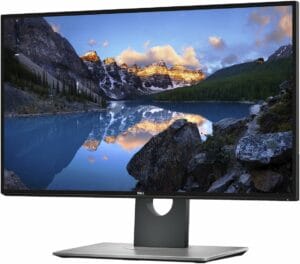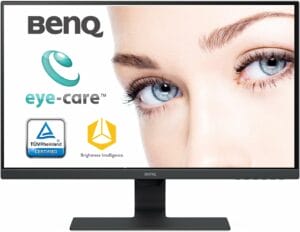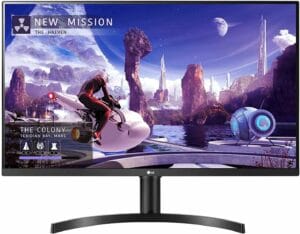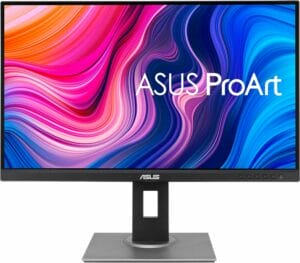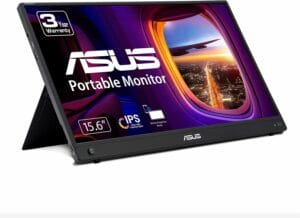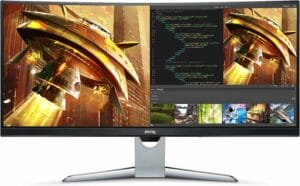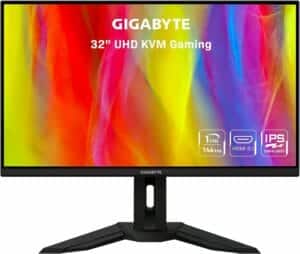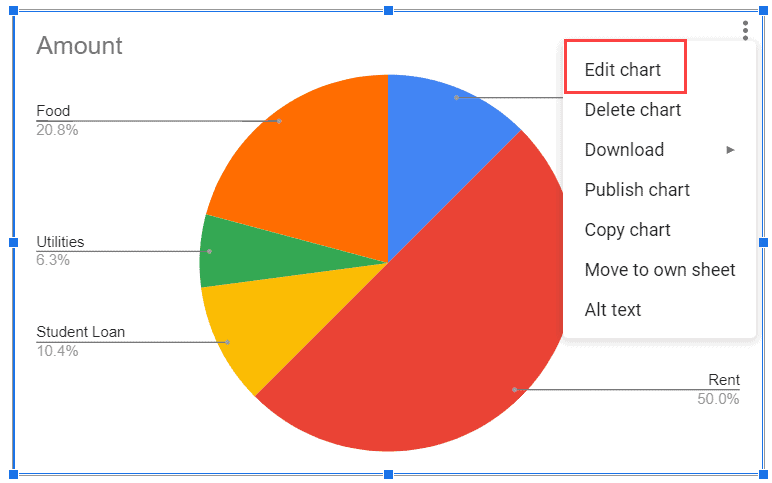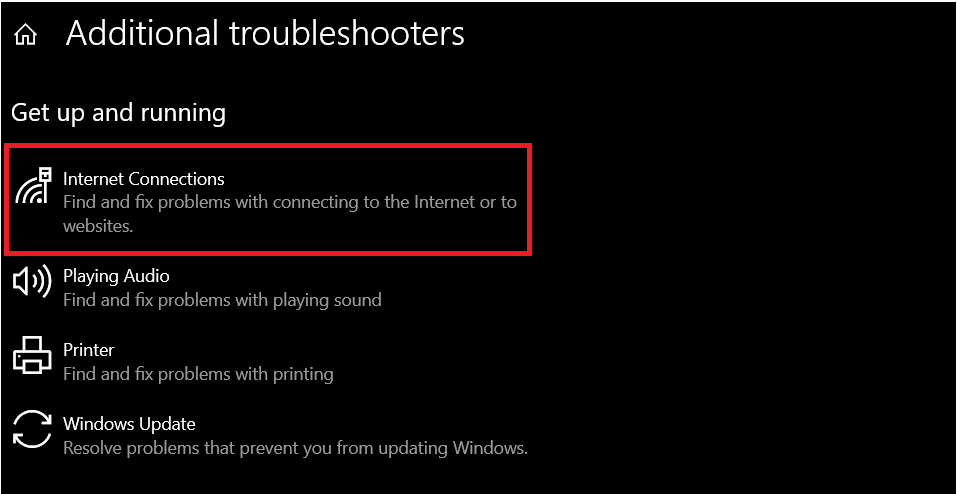Here, I reveal this year’s best monitors. You’re not alone if you find yourself getting a headache by the end of your workday because your laptop’s screen isn’t big enough. Thousands of remote workers get eye strain or fatigue on top of headaches and migraines just because they have to sit too close to their displays to see everything.
Beyond the eye strain, there’s another problem to working with just your laptop’s monitor: constantly running out of space! The best solution to both problems is to buy an external monitor. So which are the best monitors?
In this article, I put together a buying guide with all the research. This should help you sift through the best monitors for home office use and select the right one for you. Let’s get right to it!
This Article Covers:
Best Work Monitors for Your Home Office
In our opinion, the nine monitors below are some of the best computer monitors for work — especially if you want a comfortable viewing experience in your home office. Monitors don’t follow any naming convention; their names aren’t as easily recalled as laptops or other gadgets.
It may be a bit challenging to remember all these names and numbers, so make sure you’re buying the right one! Here’s a short summary of my favorites.
-
- Dell Ultrasharp U2518D – Best Home Office Monitor Overall
- ASUS VG248QG – Best Budget Monitor for WFH
- BenQ GW2780 – Best Affordable Monitor for Work
Of course, a monitor is only half the home-office upgrade. We also talked about the best laptops for working from home.
Best Monitors for Home Office Use in 2024
So here’s my list. It includes specs for each home office monitor. I also included some insight about each choice. I’ll start with the top-rated monitors for remote work, first.
1. Dell Ultrasharp U2518D – Best Home Office Monitor Overall
Specifications:
- Size: 25”
- Resolution & Aspect Ratio: 2560 x 1440 (2K UHD); 16:9
- Refresh Rate: 60Hz
- Panel Type: IPS
- Connectivity:
- 1x HDMI
- 1x DisplayPort (DP)
- 1x Mini DisplayPort (mDP)
- Audio lineout port
- 1x USB port (upstream)
- 2 x USB 3.0 port (downstream)
- VESA Mount: Yes
- Additional Features:
- Includes DP to mDP cable and USB 3.0 (upstream) cable
- Supports HDR10
If you’re looking for the best monitor for productivity, look no further than the Dell Ultrasharp U2518D. This monitor features a 2K (2560 x 1440) 1440p resolution on an IPS panel for optimum viewing angles. It works well for general productivity and some light creative work, but it doesn’t quite offer full color accuracy. The U2518D also has plenty of USB ports to act as a USB hub, allowing you to plug more devices in.
Pros
- Plenty of ports available for you to choose from
- 2K resolution is a great middle ground between FHD and 4K
- Acts like a USB hub
- Great picture all around
Cons
- Some complaints about the stand being slightly shaky
- The image will not be as sharp as 4K
2. ASUS VG248QG 24″ Monitor – Best Budget 24-inch Monitor
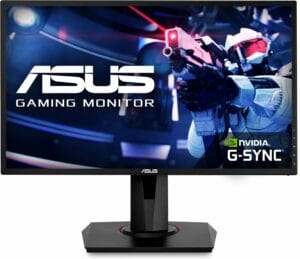
Specifications:
- Size: 24”
- Resolution & Aspect Ratio: 1920 x 1080 (FHD); 16:9
- Refresh Rate: 75Hz
- Panel Type: IPS
- Connectivity:
- 1x HDMI
- 1x VGA
- 1x 3.5mm jack
- VESA Mount: Yes
- Additional Features:
- Extreme Low Motion Blur (ELMB)
- FreeSync
- Ultra-Low Blue Light
- Comes with an HDMI cable
Although labeled a gaming monitor, the ASUS VG248QG also doubles as one of the best computer monitors for work. At 24”, this monitor is just the right size to give you more workspace without necessarily overcrowding your desk. The color accuracy is also pretty good (but not perfect), so if you do occasional graphics work, this monitor will certainly do.
Pros
- Gaming monitor that doubles as a productivity monitor
- DisplayPort and Dual-link DVI-D ports
- Under $200 price makes it appealing even when not on sale
Cons
- Some people don’t like the preset menus
3. BenQ GW2780 – Best Affordable 27” Monitor for Work
Specifications:
- Size: 27”
- Resolution & Aspect Ratio: 1920 x 1080 (FHD); 16:9
- Refresh Rate: 60Hz
- Panel Type: IPS
- Connectivity:
- Headphone jack/audio line-in
- 1x HDMI
- 1x VGA
- 1x DisplayPort
- VESA Mount: Yes
- Additional Features:
- Speakers
- Eye Care feature (low blue light, zero flicker)
- Built-in cable management system
If you want an affordable monitor at slightly bigger than 24”, this 27” monitor from BenQ might be the right one for you. This display offers eye care features that can help reduce eye strain through long, sustained work hours. It also has built-in speakers, but they’re not the best considering this display’s price.
Note that I recommended this same monitor last year. Because of the low price point, the “climate pledge friendly” tag, and the built-in cable management system, it’s still a strong value.
Pros
- Great price for the features offered
- Different ports available
- Eye care features
Cons
- Weak speakers
4. LG 32QN55T-B – Best Affordable 32” Work From Home Monitor
Specifications:
- Size: 32”
- Resolution & Aspect Ratio: 2560 x 1440 (2K QHD 1440p); 16:9
- Refresh Rate: 75Hz
- Panel Type: IPS
- Connectivity:
- 2x HDMI
- Headphone out
- VESA Mount: Yes
- Additional Features:
- sRGB 99% color accuracy + precalibrated
- Low blue light for less eye fatigue, flicker safe
- HDR10
- FreeSync
Looking for the best large monitor for work but don’t quite want an ultrawide? This LG monitor is a 32” beast offering 2K 1440p resolution. Unfortunately, it has few ports and no DisplayPort. The good news is, it has near-perfect color accuracy, making it a great choice for creatives.
I ranked this same monitor pretty highly last year. That hasn’t changed. . . except now it’s easier to find on sale. Check the current price.
Pros
- Suitable for creatives who don’t need 100% color accuracy
- Eye care features
- Massive display makes for plenty of screen real estate
Cons
- No DisplayPort
- Can cause eye fatigue due to screen size
5. Dell S2722QC – Best Monitor for Office Work for Mac Users
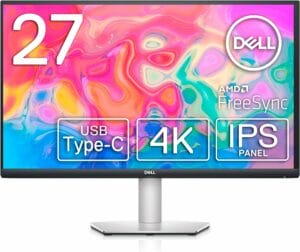
Specifications:
- Size: 27”
- Resolution & Aspect Ratio: 3840 x 2160 (4K UHD); 16:9
- Refresh Rate: 60Hz
- Panel Type: IPS
- Connectivity:
- 2x HDMI
- 2x USB 3.2 (downstream)
- USB-C (upstream)/DisplayPort
- Audio line-out
- VESA Mount: Yes
- Additional Features:
- Speakers
- FreeSync
- Security lock slot
The 27” Dell S2722QC is a 4K monitor that works great for Mac users but also works well for Windows machines. If you’re looking for the best monitor for your home office, this is an excellent choice — especially if you need more ports for your Mac machine. Once plugged in correctly, you can use this monitor like a USB hub to give your Mac more inputs.
I like this monitor for remote work. The Dell name comes with a trustworthy warranty policy. It also comes with a reasonable price point for the quality. Check the current price.
Pros
- 4K resolution
- Plenty of input and output ports
- Has speakers
- Great monitor for the price, even for non-Mac users
Cons
- Speakers are so-so
- Will require specs that can handle pushing 4K graphics (and you may not be able to push 144Hz)
6. ASUS ProArt Display PA278QV – Best WFH Monitor for Creatives
Specifications:
- Size: 27”
- Resolution & Aspect Ratio: 2560 x 1440 (WQHD 1440p); 16:9
- Refresh Rate: 75Hz
- Panel Type: IPS
- Connectivity:
- 1x mDP
- 1x DP
- 1x HDMI
- 1x DVI-D
- Earphone jack/audio in
- 4 x USB 3.0
- VESA Mount: Yes
- Additional Features:
- 100% sRGB
- Eye care, anti-glare
- Calman verified for color accuracy
The ASUS ProArt Display line of products can help you find the best monitor for working from home if you are a creative professional needing 100% color accuracy. Plenty of creatives love this monitor for its excellent handling of color and graphics. The eye care features also prevent eye strain.
Like Dell, the ASUS brand earned a reputation for quality. I like this for the overall value and, of course, the climate-pledge badget. Check the current price.
Pros
- Incredible color accuracy, excellent for creative professionals who need it for work
- Eye care features
- Plenty of ports
- Good price for the features on offer
Cons
- Some complaints of issues with DisplayPort
7. ASUS Zenscreen Go – Best Portable Monitor for Remote Workers
Specifications:
- Size: 15.6”
- Resolution & Aspect Ratio: 1920 x 1080 (FHD); 16.9
- Refresh Rate: 60Hz
- Panel Type: IPS
- Connectivity:
- 1x Mini HDMI
- 2 x USB-C
- 3.5mm jack
- Wireless mirroring support
- VESA Mount: No
- Additional Features:
- Eye care, anti-glare coating
- Socket for tripod so you can mount your monitor if necessary
- Built-in 7800mAh battery, enough for 3.5~ hours of use (maybe more depending on your usage)
- Ergonomic kickstand
If you’re the type who doesn’t like sitting still in one spot, the ASUS Zenscreen Go is the perfect choice for you. Though on the smaller side, this 15.6” display is one of the best monitors for productivity if you also travel a lot for work. It even has a built-in battery to allow wireless use, though the battery doesn’t last all that long (depending on use).
You’ll notice several ASUS monitors in this buying guide. This one earned a spot because of the unique portability it offers. I also trust the name and appreciate the overall value. Check the current price.
Pros
- Plenty of ports
- Supports wireless mirroring
- IPS panel is great for viewing angles
- Slim, light, portable
Cons
- Battery life is mediocre, but you can charge via a power bank
- Only 15.6”
8. BenQ EX3501R – Best Ultrawide Monitor for Office Work
Specifications:
- Size: 35” Curved
- Resolution & Aspect Ratio: 3440 x 1440 (WQHD 1440p); 21:9
- Refresh Rate: 100Hz
- Panel Type: VA
- Connectivity:
- 2x HDMI
- 1x DisplayPort
- 2x USB 3.0 (downstream)
- 1x USB-C
- VESA Mount: Yes, but it requires custom mounting kit (additional purchase)
- Additional Features:
- HDR10
- FreeSync
- Low blue light, flicker-free
- 100% sRGB
If you want the most screen real estate possible, the best monitor for office work for you would be an ultrawide like the BenQ EX3501R. This monitor uses a VA panel rather than IPS, giving it better contrast but slightly worse viewing angles. Nevertheless, the eye care features help you avoid headaches and eye strain. Plus, there are plenty of ports to help you use this display, like a USB hub.
Like Dell and ASUS, the BenQ brand earns top mentions in my resarch. I’ve used BenQ montiors regularly for years. It’s a reliable brand and, with an ultrawide screen, this model presents notable value. Check the current price.
Pros
- Plenty of ports to choose from
- Eye care features
- Large display
- Good refresh rate
Cons
- Requires a lot of space — pretty big desk footprint overall
- Not everyone likes curved profiles
- Requires additional purchase for VESA mounting
9. Gigabyte M32U – Best 4K Monitor for Working From Home
Specifications:
- Size: 32” (31.5” actual)
- Resolution & Aspect Ratio: 3840 x 2160 (4K); 16:9
- Refresh Rate: 144Hz
- Panel Type: IPS
- Connectivity:
- 1x DisplayPort
- 2x HDMI 2.1
- 1x USB-C
- 3x USB 3.0
- VESA Mount: Yes
- Additional Features:
- 1ms response time, good for gaming
- FreeSync
- Built-in KVM (keyboard video and mouse switch)
The Gigabyte M2U is on the larger side at 32”, but at a 4K resolution, you get bang for the buck and a ton of room to work and multitask. This monitor has plenty of ports to allow you to connect your dongles and devices. But what really makes this monitor stand out is the 144Hz refresh rate and 1ms response time, which makes it great for gaming or entertainment. Of course, you’ll need a laptop that can push these rates, such as one with a GPU or a newer MacBook with an M1/M2 chip. If you don’t, you can still use this monitor in 4K at a lower refresh rate.
This is the priciest remote work monitor on my list. Still, it earns marks for value. If you can find this on sale, it provides plenty of ports and a fast response time. Check the current price.
Pros
- Plenty of ports, so you can use whichever one you need
- Fast response time makes it great for gaming
- 144Hz refresh rate will offer buttery smooth movements and animations
Cons
- Priciest remote work monitor in my guide
- Will require specs that can handle pushing 4K graphics (and you may not be able to push 144Hz)
How To Choose the Best Work From Home Monitors
Shopping around can be overwhelming, especially if you’re unfamiliar with all the terminology and technology around displays. There are a ton of monitors out there, which means there are also plenty of options regarding the best monitors for working from home.
If you’d like guidance on what to consider as you choose your monitor, consider the factors below!
Price
The first thing you’ll need to consider is your budget. Work monitors come in various price ranges. You can spend anywhere from a hundred to a thousand dollars, depending on your choice of display. Establish how much you’re willing to pay before considering the other factors below — it’ll make it easier for you to create a shortlist of monitors to choose from.
We discuss price often here, as it’s half the equation when determining overall value. For example, we discussed alternatives to magic keyboards because off-brands often have lower price points. When it comes to the best monitors for remote work, the same rule applies. We considered trusted brands, and we considered reliable and highly-rated monitors from lesser-known brands.
Size and Resolution
Your monitor’s size is how large the display is when measured diagonally. You’ll find that monitors come in various sizes, just like televisions. The size you need for your monitor will mostly depend on how much space you have and how much screen space you want.
We recommend a monitor that’s at least 24 inches in size just to give you enough screen space and reduce eye strain simultaneously. However, many find that a 27-inch monitor or larger is more their preference. It’s worth mentioning that if your monitor is too big, you may get some eye fatigue from having to move your eyes more to see.
Regarding resolution, we’d recommend a minimum of 1080p (Full HD or FHD), which comes out to 1920 x 1080 pixels. This is the “standard” resolution these days and is good enough for most purposes. However, some people may prefer higher resolutions and more pixels per inch, which results in cleaner images all around.
Aspect Ratio
The aspect ratio is your screen’s width to height ratio. You’ll usually see it shown as two numbers with a colon ( : ) separator in the middle. 1920 x 1080 is a 16:9 aspect ratio, and as you might guess, the 16:9 ratio is the most common one as well. However, if you want an ultrawide monitor, that’s usually a 21:9 ratio.
Refresh Rate
Refresh rate refers to how many times your monitor refreshes the image on your screen every second. The most common is 60Hz, which will refresh the image sixty times each second. The higher the refresh rate, the smoother moving objects will look on your screen. However, high refresh rates mean more expensive monitors that need better laptop specs to handle.
For most use cases, 60Hz is enough. However, 90 to 120Hz seems to be a good spot if you do a lot of creative work. Gamers often want at least 144Hz.
Panel Type
The type of panel your monitor can determine the viewing angles of your monitor. We’d recommend an IPS display! An IPS monitor offers almost perfect viewing at any angle. However, a TN display only has 160º to 170º viewing angles, meaning your screen won’t be viewable from certain positions and distances.
Connectivity
Another thing to consider is how your monitor connects to your laptop. Does your monitor have HDMI or a DisplayPort? Either way, you’ll need to figure out a way to connect it to your machine. You’ll need a dongle or adapter if your laptop doesn’t have an HDMI port. Note that we also recently discussed how to mirror your iPhone to TV.
Additional Features
- Color accuracy: If you are a creative professional, color accurate displays are practically a necessity. Make sure you look into monitors with color accuracy features and don’t forget to calibrate the display before you use it!
- VESA mount: Although not necessary, monitors for home office use with VESA mounts can help you improve your setup if you need to. Many VESA-mount monitor arms, stands, and accessories help you get your perfect WFH setup.
- Curved: Some displays are curved. Some people like them, others hate them — it depends on your preference.
- Eye care: Many monitors advertise eye care features such as low blue light or blue light filters, which can help reduce eye strain. If you’re choosing the best home office monitor, we recommend one with eye care features.
How To Use an External Monitor With a Laptop
Using an external monitor with your laptop is pretty straightforward — all you have to do is plug one in. In most cases, you’ll have to plug your external monitor into the power socket to give it power. The only time you won’t need to do this is if you are using a tablet or a portable monitor that can be powered through USB or Thunderbolt.
Look at your laptop to ensure you have an HDMI or a Thunderbolt port compatible with DisplayPort. Then, if you have an HDMI port, all you’ll have to do is plug your monitor in. However, if you only have a Thunderbolt port, you’ll need a dongle or adapter to ensure your monitor can connect to your laptop.
Once you’ve plugged your monitor in, you can configure it following the steps below.
Read More: The Best Macbook Pro Alternatives
How To Configure Your External Monitor
When you first plug in your monitor, it will mirror your laptop’s display. That means whatever you see on your laptop is what you’ll see on your monitor. If you just want to connect your monitor to your laptop to enlarge your display, you don’t need to do anything else. However, if you want to extend your display so that you have two monitors (your laptop’s and your monitor’s), here’s how to do it. Remember that your monitor has to be plugged into your computer for these methods to work!
Configuring Your Monitor for Windows
The first thing you’ll have to do on Windows is to right-click on your desktop to bring up the context menu. Click on Display Settings.
In the Display Settings, scroll down to Multiple Displays. You’ll need to find the option that says Extend Desktop and select it. You will then see that your monitor is no longer an exact copy of your laptop’s. You’ll also be able to move your mouse into your second screen and know that you’ve doubled your workspace.
Within this window, you’ll be able to arrange your displays however you prefer.
Configuring Your Monitor for macOS
Setting your monitor up for macOS is a similar endeavor.
You’ll need to go to your top menu bar, click on the Apple logo/icon, and then go to System Preferences. You can also navigate to your system preferences through Spotlight (Command + Spacebar or the magnifying glass on your top menu bar) by typing system preferences and pressing enter.
Click on Displays. Then, go to the Arrangement tab and uncheck Mirror Displays to extend your display instead. From this page, you can also arrange your screens to your preference.
Quick Tip for Mac Users
Apple allows you to use a compatible iPad as a secondary display through the Sidecar feature. Sidecar allows you to extend your display anywhere and everywhere you are. iPads aren’t the largest screens out there, but they do great if you’re looking for a portable option. Of course, it requires you to own an iPad already, but hey — it’s still quite a handy tip!
It’s worth mentioning that there are also other apps out there that can help you turn any tablet into a secondary display for Mac or Windows. Although they’ll do in a pinch, they’re still not the best option if you work out of your home office daily.
Read More: The Best Macbook Air Alternatives
How We Test the Best Monitors for Home Offices
In testing the best monitors for home office workers, we’ve researched the top products available as of writing. We considered various aspects of each monitor, such as its price, size, resolution, color accuracy, and more, in order to provide our recommendations for different types of office work.
Additionally, we did plenty of research into each product to see whether the reviews are generally positive and if most who’ve bought the product recommend it to others. We also looked into each manufacturer to see whether they have a track record of reliability and if it would be easy to get support in case of any issues.
Finally, we also asked a few professionals (from different industries) which product they chose to win the title of best office monitor.
Frequently Asked Questions
Do I Need a 4K Monitor for Office Work?
Not at all! Unless the type of work you do demands it (or if you want to also use your monitor for watching 4K videos), you don’t have to pay more for a 4K monitor. Note that if you want to use a 4K monitor, your laptop’s specs need to be able to handle that type of display, or you might run into problems!
What Type of Monitor Is Best for My Home Office?
The type of home office monitor you’ll want depends on the kind of work that you do. For example, if you just do general productivity work and various similar tasks, even a basic monitor will do. If you’re a creative professional, you’ll probably want a color-accurate display. No matter the type of work you do, choose a monitor with “eye care” features like low blue light or blue light filters.
What Size Monitor Is Best for Work From Home?
When buying a monitor for your office at home, the best size will depend on how much space you have. We’d recommend choosing at least a 24-inch monitor as this appears to be the sweet spot in terms of enough screen real estate while still fitting in smaller spaces. Monitors larger than 32 inches may cause eye strain and fatigue, but your mileage may vary.
Are Bigger Monitors Better for Your Eyes?
Not necessarily, because the larger your screen, the more distance your eyes have to travel when you’re reading or looking at something. This extra distance can contribute more to eye strain, leading to headaches and eye fatigue. When selecting the best monitor for work, it’s more important to have a large enough screen at the proper distance and at the right brightness.
Read More: The Best Mouse for Macbook Pro and Air
Conclusion
Furnishing your home office is a deeply personal experience. Because you’ll be spending so much of your time there almost every day, it’s a good idea to ensure that yours is comfortable, cozy, and free from distractions that can make your workday much more challenging. The right monitor can help make your space more conducive to productivity.
We hope this guide has helped you choose among the best monitors for home office use. If you think we missed a monitor that belongs on this list, let us know in the comments below!
Related:
- Best Office Chair For Back Pain
- The Best Work from Home Apps
- Top Laptops For Video Editing

